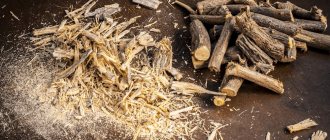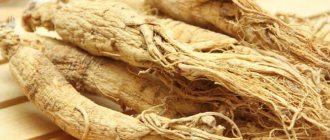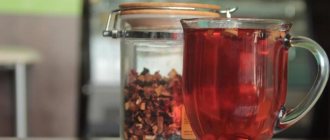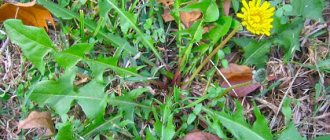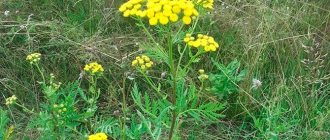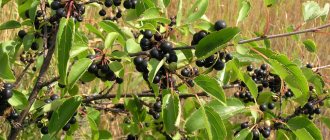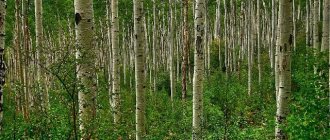Collected at different times of the year, unpeeled (naturales) or peeled (mundatae) from the cork, are the roots and underground shoots of perennial wild herbaceous plants licorice naked - Glycyrrhiza glabra L. and Ural licorice - Glycyrrhiza uralensis Fisch., fam. legumes - Fabaceae.
MINISTRY OF HEALTH OF THE RUSSIAN FEDERATION
PHARMACOPOEIAL ARTICLE
Licorice roots FS.2.5.0040.15
Glycyrrhizae radices Instead of GF X , Art. 573
(amendment No. 1 dated 02/17/1999)
Collected at different times of the year, unpeeled (naturales) or peeled (mundatae) from the cork, are the roots and underground shoots of perennial wild herbaceous plants licorice naked - Glycyrrhiza glabra L. and Ural licorice - Glycyrrhiza uralensis Fisch., fam. legumes - Fabaceae.
AUTHENTICITY
External signs
Whole raw materials. Pieces of roots and underground shoots of cylindrical shape of various lengths and thicknesses. There are pieces of roots that turn into a strongly overgrown rhizome more than 10 cm thick.
The surface of unpeeled roots and shoots is longitudinally wrinkled, covered with a grayish-brown or brown cork; the cleaned raw material is light yellow to brownish-yellow in color on the outside with minor remains of cork; fracture from light yellow to yellowish-orange, granular-fibrous.
When viewed under a magnifying glass (10×) or a stereomicroscope (16×), a cross section of roots and underground shoots reveals numerous wide medullary rays and elongated groups of vessels, giving a clearly visible radiant structure. Radial cracks often form along the medullary rays. The shoots have a small core, the roots do not have a core. The smell is weak. The taste of the aqueous extract is sweet, cloying, slightly irritating.
Crushed raw materials. Pieces of raw materials of various shapes, usually fibrous, ranging in size from 1 to 10 mm (for unrefined raw materials) and from 1 to 6 mm (for purified raw materials) or passing through a sieve with holes measuring 6 mm (for medicinal herbal preparations).
The color of the purified raw material is from light yellow to brownish yellow with minor remains of cork; unrefined raw materials - yellow, grayish-yellow, brownish-yellow, with remains of grayish-brown or brown cork. The smell is weak, the taste of the aqueous extract is sweet, cloying, slightly irritating.
Powder. Pieces of raw materials of various shapes, usually fibrous, pass through a sieve with holes measuring 2 mm.
The color of the purified raw material is from light yellow to brownish yellow with minor remains of cork; unrefined raw materials - yellow, grayish-yellow, brownish-yellow, with remains of grayish-brown or brown cork. The smell is weak. The taste of the aqueous extract is sweet, cloying, slightly irritating.
Microscopic signs
Whole raw materials. When examining cross-sectional micropreparations, a multilayer plug should be visible in an unpeeled root; under the plug there is a primary cortex, consisting of large elongated cells, often with prismatic crystals of calcium oxalate (in cleaned roots, the primary cortex is also partially removed along with the plug). The primary cortex passes into a well-developed wide secondary cortex, in which wide medullary rays, sometimes expanding towards the surface, are visible, alternating with a bast consisting of sieve tubes, bast fibers and parenchyma cells. The sieve tubes, except for the narrow layer adjacent to the cambium, are compressed and represent a deformed (obliterated) bast, forming an elongated cone, with its wide base facing the cambium, and the elongated apex passes, bending between groups of bast fibers. Bast fibers with strongly thickened walls and a narrow cavity are collected in groups and surrounded by a crystal-bearing lining. The parenchyma cells of the cortex and medullary rays contain starch grains - simple, round or ovoid. The wood consists of vessels of different diameters - from narrow to very wide, groups of sclerenchyma fibers with a crystalline lining and parenchyma containing starch. When stained with iodine solution, the medullary rays and parenchyma turn blue, the deformed bast does not stain and remains grayish, the vessels become yellow, and groups of bark and wood fibers turn orange. On a longitudinal-radial section in the bark and wood, long, highly thickened sclerenchyma fibers with a crystalline lining are visible; in wood there are narrow vessels - mesh, medium - with slit-like pores and wide - with barrel-shaped short segments and slit-like bordered pores located in oblique rows.
Crushed raw materials and powder. When examining micropreparations, fragments of thin-walled parenchyma should be visible, consisting of round or rounded-polygonal cells, often with groups of prismatic crystals of calcium oxalate; groups of bark and wood fibers, usually with a crystalline lining; fragments of bast with sieve tubes; fragments or groups of mesh vessels of various diameters with slit-like bordered pores, often accompanied by bundles of fibers (segments of wide vessels are usually short, barrel-shaped); cork fragments consisting of several layers of polygonal cells.
Licorice roots
Drawing -
1 – fragment of a cross section of an unpeeled root: a – plug, b – bast fibers, c – obliterated bast, d – xylem vessels, e – parenchyma of the medullary rays (40×); 2 – fragment of multilayer cork (200×); 3 – fragment of a longitudinal section: a – parenchyma cells, b – mesh vessels with bordered slit-like pores (400×); 4 – root fragment: a – sieve tubes of bast, b – fibers with a crystalline lining (200×); 5 – root fragment: a – parenchyma cells of the cortex with prismatic crystals of calcium oxalate (200×)
Licorice - benefits
Licorice can lower cholesterol levels in the blood, so taking it is beneficial for the functioning of the cardiovascular system. Periodic use of medicines from the plant provides nutrition to brain cells, which gives a feeling of satisfaction and improves mood. The high content of nutrients in licorice helps improve the appearance of skin, hair and nails if plant preparations are taken orally.
Licorice roots contain such a valuable component as the glycoside liquircitin. The substance is a natural stimulator of insulin production. Therefore, consuming licorice helps normalize the function of the pancreas and ensures its secretion. The component is used as a natural sweetener, so licorice root will be useful for patients with diabetes.
Taking licorice may be a form of preventing allergic reactions in people who are prone to them. Flavonoids in licorice roots include compounds that are not produced by the body on its own. They act as antioxidants and have an important property - the ability to block histamines.
In the form of decoctions and infusions, as well as herbal teas, licorice serves as a diuretic and decongestant. Due to components such as saponins, the production of digestive enzymes is stimulated and metabolism improves. The substances activate the glands, so they help cleanse the body of toxins. Also, a doctor may prescribe licorice extract with a high concentration of saponins for kidney failure.
Determination of the main groups of biologically active substances
Thin layer chromatography
Preparation of solutions.
Standard solution (RS) of 18β-glycyrrhizic acid. About 0.005 g of CO monoammonium salt of glycyrrhizic acid is dissolved in 1 ml of a mixture of 96% alcohol - water (1:1 v/v). The shelf life of the solution is no more than 3 months when stored in a cool, dark place.
Quercetin CO solution. About 0.001 g of quercetin CO is dissolved in 10 ml of 96% alcohol. The shelf life of the solution is no more than 3 months when stored in a cool, dark place.
About 0.5 g of raw material, crushed to the size of particles passing through a sieve with holes measuring 0.5 mm, is placed in a conical flask with a ground section with a capacity of 100 ml, 10 ml of a mixture of 96% alcohol - water (1: 1) is added and boiled with reflux in a boiling water bath for 10 minutes. After cooling to room temperature, the extract is filtered through a paper filter (test solution).
On the starting line of an analytical chromatographic plate with a layer of silica gel with a fluorescent indicator on an aluminum or polymer substrate measuring 10 × 10 cm, 5 μl of the test solution is applied in the form of strips 10 mm long, no more than 3 mm wide and, on top of each other (in one strip) and 5 μl of solutions of CO 18β-glycyrrhizic acid and CO quercetin. The plate with the applied samples is dried at room temperature, placed in a chamber (without preliminary saturation) with a mixture of solvents n-butanol - glacial acetic acid - water (7: 1: 2) and chromatographed using the ascending method. When the front of solvents has passed about 80 - 90% of the length of the plate from the starting line, it is removed from the chamber, dried until traces of solvents are removed, and viewed under UV light at a wavelength of 254 nm.
On the chromatogram of a solution of CO 18β-glycyrrhizic acid and a solution of CO quercetin, 2 dark zones of adsorption should be detected.
The chromatogram of the test solution should show 2 main dark zones of adsorption at the level of zones on the chromatograms of a solution of CO 18β-glycyrrhizic acid and a solution of CO quercetin, 1 or 2 less pronounced adsorption zones in between; detection of other adsorption zones is allowed.
general information
Licorice belongs to the legume family.
Initially it grew in the Mediterranean, Asia Minor and Central Asia. Licorice began to be actively used in medicine after the plant came to China and Tibet. Licorice glabra grows in places protected from the winds. The plant can tolerate overheating and cooling of the soil, but not frost. It grows in fields, steppes and semi-steppes, near seas, along river valleys and on sand. May form thickets. Licorice glabra is widespread in the North Caucasus, Eastern Transcaucasia, along the lower reaches of the Don and Volga, in Crimea, on the coast of the Sea of Azov, and in southeastern Europe. Ural licorice is found in the Southern Urals, Kyrgyzstan, Western and Eastern Siberia, and Kazakhstan.
TESTS
Humidity
Whole raw materials, crushed raw materials: unrefined - no more than 14%; purified - no more than 14%. Powder - no more than 14%.
Total ash
Whole raw materials, crushed raw materials: unrefined - no more than 8%; purified - no more than 8%. Powder - no more than 8%.
Ash, insoluble in hydrochloric acid
Whole raw materials: unrefined – no more than 2.5%; purified - no more than 1%. Crushed raw materials: unrefined - no more than 2.5%; purified - no more than 2.5%. Powder - no more than 2.5%.
Raw material grinding
Crushed raw materials (unrefined and purified): particles that do not pass through a sieve with holes measuring 10 mm - no more than 5%; particles passing through a sieve with holes measuring 0.5 mm, no more than 5%; particles that do not pass through a sieve with holes measuring 6 mm - no more than 5%; particles passing through a sieve with holes measuring 0.18 mm, no more than 5%; Powder: particles that do not pass through a sieve with holes measuring 2 mm - no more than 5%; particles passing through a sieve with holes measuring 0.18 mm, no more than 5%.
Foreign matter
Roots, flabby at the fracture, yellow-brown, and remains of stems. Whole raw materials: unrefined – no more than 4%.
Roots poorly cleared of cork. Whole raw materials: purified - no more than 15%.
Note. Roots with remnants of more than 3 sections of dark brown plug on one piece or when the diameter of the remnants of the plug is more than 10 mm are considered poorly cleaned.
Roots, darkened and dark brown on the surface, but light yellow at the break. Whole raw materials: purified - no more than 20%.
Root particles darkened on the surface. Crushed raw materials: purified – no more than 15%.
Particles that are poorly cleared from the cork. Crushed raw materials: purified – no more than 3%.
Organic impurity. Whole raw materials: unrefined – no more than 1%; purified - no more than 0.5%. Crushed raw materials: unrefined - no more than 1%; purified - no more than 0.5%.
Mineral impurity. Whole raw materials: unrefined – no more than 1%; purified - no more than 0.5%. Crushed raw materials: unrefined - no more than 1%; purified - no more than 0.5%. Powder - no more than 1%.
Heavy metals
In accordance with the requirements of the General Pharmacopoeia Monograph “Determination of the content of heavy metals and arsenic in medicinal plant materials and medicinal herbal preparations.”
Radionuclides
In accordance with the requirements of the General Pharmacopoeia Monograph “Determination of radionuclide content in medicinal plant materials and medicinal herbal preparations.”
Pesticide residues
In accordance with the requirements of the General Pharmacopoeia Monograph “Determination of the content of residual pesticides in medicinal plant materials and medicinal herbal preparations.”
Microbiological purity
In accordance with the requirements of the General Pharmacopoeia Monograph “Microbiological purity”.
quantitation
Whole raw materials (unrefined and purified), crushed raw materials (unrefined and purified), powder: glycyrrhizic acid content - not less than 6%
An analytical sample of raw materials is crushed to the size of particles passing through a sieve with holes measuring 0.2 mm. About 2.0 g (exactly weighed) of crushed raw material is placed in a conical flask with a capacity of 150 ml, 20 ml of acetone solution of nitric acid 3% is added and the mixture is left for 1 hour with frequent and strong stirring. The extract is filtered into a 100 ml cylinder and washed with 10 ml of acetone and filtered through the same filter. Another 20 ml of acetone is added to the flask with the raw material, which is used to simultaneously wash the raw material from the filter, and the mixture is refluxed in a water bath for 5 minutes. The extract is filtered through the same filter into the same cylinder. Extraction with hot acetone is thus repeated 2 more times, washed with acetone until the volume in the cylinder reaches 100 ml. The extract from the cylinder is poured into a 200 ml glass. The cylinder is rinsed with 40 ml of alcohol, which is then poured into the same glass. Next, a concentrated ammonia solution is added drop by drop with vigorous stirring until an abundant light yellow cheesy sediment appears (pH 8.3 - 8.6 is set potentiometrically or by the pinking of wet phenolphthalein paper). The precipitate along with the mother liquor is transferred to a filter placed in a Buchner funnel, and the liquid is sucked off. The glass and filter with sediment are washed with 50 ml of acetone in 3-4 steps. The precipitate with the filter is transferred to the glass in which the precipitation was carried out and dissolved in 50 ml of water. The resulting solution is quantitatively transferred into a 250 ml volumetric flask. The filter is washed several times with small portions of water and added to the main solution. Bring the volume of solution to the mark (solution A).
3.0 ml of solution A is placed in a 50 ml volumetric flask and the volume of the solution is adjusted to the mark with water (solution B).
The optical density of solution B is measured on a spectrophotometer at a wavelength of 258 nm in a cuvette with a layer thickness of 10 mm; water is used as a reference solution.
The content of glycyrrhizic acid in absolutely dry raw materials in percent (X) is calculated using the formula:
Where:
A – optical density of solution B;
a – sample of raw materials, g;
822 – molecular weight of glycyrrhizic acid;
11000 is the molar absorption rate.
Packaging, labeling and transportation
In accordance with the requirements of the General Pharmacopoeia Monograph “Packaging, labeling and transportation of medicinal herbal raw materials and medicinal herbal preparations.”
Storage
In accordance with the requirements of the General Pharmacopoeia Monograph “Storage of medicinal plant raw materials and medicinal herbal preparations”.
Download in PDF FS.2.5.0040.15 Licorice roots
